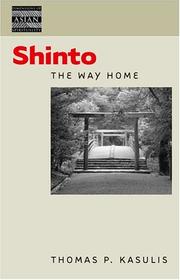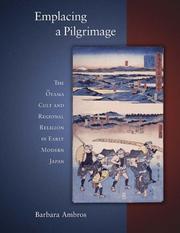| Listing 1 - 10 of 14 | << page >> |
Sort by
|

ISBN: 0824827945 082482850X 9780824827946 9780824828509 Year: 2004 Publisher: Honolulu University of Hawaii press
Abstract | Keywords | Export | Availability | Bookmark
 Loading...
Loading...Choose an application
- Reference Manager
- EndNote
- RefWorks (Direct export to RefWorks)
Shinto. --- J1940 --- Japan: Religion -- Shintō in general --- J1910 --- Japan: Religion -- Shintō -- general and history --- Shinto --- Religions
Book
ISBN: 1350191582 1350179426 9781350191587 9781350179394 Year: 2022 Publisher: London Bloomsbury Academic
Abstract | Keywords | Export | Availability | Bookmark
 Loading...
Loading...Choose an application
- Reference Manager
- EndNote
- RefWorks (Direct export to RefWorks)
Shugen (Sect) --- Kimbusen Shugen Honshu --- Shugendō --- Buddhist sects --- Shingon (Sect) --- Tendai (Sect) --- History --- J1940 --- Japan: Religion -- Shugendō
Book
ISBN: 0700704469 0700704477 9780700704477 9780700704460 Year: 1996 Publisher: London Curzon
Abstract | Keywords | Export | Availability | Bookmark
 Loading...
Loading...Choose an application
- Reference Manager
- EndNote
- RefWorks (Direct export to RefWorks)
Shinto --- Dictionaries. --- Dictionnaire anglais --- Shinto. --- Sjintoïsme. --- Schintoismus. --- Wörterbuch. --- S35/1000 --- J1940.60 --- #SML: De Weirdt --- Japan--Religion --- Japan: Religion -- Shintō -- reference works --- J1911.60 --- Shintō
Book
ISBN: 0700700072 9780700700073 Year: 1971 Publisher: London Curzon
Abstract | Keywords | Export | Availability | Bookmark
 Loading...
Loading...Choose an application
- Reference Manager
- EndNote
- RefWorks (Direct export to RefWorks)
Periodical
ISSN: 13422421 Year: 1996 Publisher: Tokyo Jinja honchō kyōgaku kenkyūjo
Abstract | Keywords | Export | Availability | Bookmark
 Loading...
Loading...Choose an application
- Reference Manager
- EndNote
- RefWorks (Direct export to RefWorks)

ISBN: 0810840162 Year: 2002 Volume: 38 Publisher: Lanham Scarecrow
Abstract | Keywords | Export | Availability | Bookmark
 Loading...
Loading...Choose an application
- Reference Manager
- EndNote
- RefWorks (Direct export to RefWorks)
Shinto --- Japanese language --- Japonais (Langue) --- Dictionaries --- English --- Dictionnaire anglais --- Dictionnaires anglais --- J1940.60 --- J1970 --- -Shinto --- -Religions --- Koguryo language --- Japan: Religion -- Shintō -- reference works --- Japan: Religion -- Shintō -- history --- Japanese --- -Japan: Religion -- Shintō -- reference works --- J1910 --- Japan: Religion -- Shintō -- general and history --- J1911.60 --- Shintō --- Religions --- Dictionaries.
Book
ISBN: 9780824837136 Year: 2013 Publisher: Honolulu University of Hawaii Press
Abstract | Keywords | Export | Availability | Bookmark
 Loading...
Loading...Choose an application
- Reference Manager
- EndNote
- RefWorks (Direct export to RefWorks)
J1944 --- J1940.60 --- Japan: Religion -- Shintō -- shrines and pilgrimage --- Japan: Religion -- Shintō -- reference works --- J1911.60 --- J1918 --- Shinto shrines --- Shinto --- Shinto rites and ceremonies --- Shinto temples --- Shrines, Shinto --- Temples, Shinto --- Shinto pilgrims and pilgrimages --- Customs and practices --- Rites and ceremonies --- Rituals --- Shrines
Book
ISBN: 9783700174004 3700174004 Year: 2013 Volume: 840 78 Publisher: Wien Österreichische Akademie der Wissenschaften
Abstract | Keywords | Export | Availability | Bookmark
 Loading...
Loading...Choose an application
- Reference Manager
- EndNote
- RefWorks (Direct export to RefWorks)
Shinto is often regarded as Japan’s indigenous religion retaining archaic elements of animism and nature worship. At the same time, Shinto is sometimes seen as nothing else than a nationalistic political ideology. After all, in 1868 Japan turned into a modern nation state and worship at Shinto shrines became a national cult. This so-called State Shinto was eventually abolished under the Allied Occupation in 1946 but the historical links between Shinto and Japanese nationalism led to an ambiguous evaluation of Shinto not only at the popular level but also at the level of scientific research. The present volume comprises eight essays by leading experts of Japanese intellectual history from Japan, Europe, and the USA who tackle this issue from the point of view of research history: What is the impact of State Shinto on Shinto research before and after the Second World War? How did Japanese and international scholars contribute and/or react to the ideological framework of Japanese nationalism? How did nationalist discourses of other countries (in particular German National Socialism) influence the representation of Shinto? As each essay addresses these issues from a specific angle, it becomes clear that there never was just one ideology of State Shinto. Moreover, the emphasis on Shinto ritual by the political authorities weakened the significance of academic research of Shinto as a tool of propaganda. Regarding the concept of Shinto proper, the impact of modern, “westernized” religious studies seems at least as important as traditional, “nativist” approaches.
Democracy --- Constitutional history --- Emperors --- Démocratie --- Histoire constitutionnelle --- Empereurs --- History. --- Histoire --- Japan --- Japon --- Economic policy --- Politics and government --- Politique économique --- Politique et gouvernement --- Shinto and politics --- Shinto --- History --- Religion --- J1940.50 --- J1970.80 --- Japan: Religion -- Shintō -- study and teaching --- Japan: Religion -- Shintō -- history -- Gendai, modern (1926- ), Shōwa, 20th century --- J1911.50 --- J1910.80 --- Démocratie --- Politique économique --- Shinto and politics - Japan --- Shinto - History --- Japan - Religion - History

ISBN: 1873410859 9781873410851 Year: 1999 Publisher: Sandgate Japan library
Abstract | Keywords | Export | Availability | Bookmark
 Loading...
Loading...Choose an application
- Reference Manager
- EndNote
- RefWorks (Direct export to RefWorks)
J1723.20 --- J1997 --- J1964 --- J1882 --- Japan: Religion in general -- shamanism --- Japan: Religion -- Shugendō (Tōzanpa and Honzanpa) --- Japan: Religion -- Shintō -- new religions -- Ontake kyō --- Japan: Religion -- Buddhism -- Nichiren --- -Japan: Religion in general -- shamanism --- Japan: Religion in general -- shamanism. --- Japan: Religion -- Shugendō (Tōzanpa and Honzanpa). --- Japan: Religion -- Shintō -- new religions -- Ontake kyō. --- Japan: Religion -- Buddhism -- Nichiren. --- J1914.58 --- Japan: Religion -- Shintō -- sects and schools -- new -- Ontakekyō --- J1940 --- Japan: Religion -- Shugendō --- Shamanism --- -Religions --- -Japan: Religion -- Buddhism -- Nichiren. --- -Shamanism --- -Shamanism -

ISBN: 9780674027756 0674027752 1684174694 9781684174690 Year: 2008 Publisher: Cambridge Harvard university Asia center
Abstract | Keywords | Export | Availability | Bookmark
 Loading...
Loading...Choose an application
- Reference Manager
- EndNote
- RefWorks (Direct export to RefWorks)
Towering over the Kanto Plain, the sacred mountain Oyama (literally, "Big Mountain") has loomed large over the religious landscape of early modern Japan." "By the Edo period (1600-1868), the revered peak had undergone a transformation from secluded spiritual retreat to popular pilgrimage destination. Its status as a regional landmark among its devotees was boosted by its proximity to the shogunal capital and the wide appeal of its amalgamation of Buddhism, Shinto, mountain asceticism, and folk beliefs. The influence of the Oyama cult - the intersecting beliefs, practices, and infrastructure associated with the sacred site - was not lost on the ruling Tokugawa shogunate, which saw in the pilgrimage an opportunity to reinforce the communal ideals and social structures that the authorities espoused. Barbara Ambros provides a detailed narrative history of the mountain and its place in contemporary society and popular religion by focusing on the development of the Oyama cult and its religious, political, and socioeconomic contexts. Richly illustrated and carefully researched, this study emphasizes the importance of "site" or "region" in considering the multifaceted nature and complex history of religious practice in Tokugawa Japan.
Mountain worship --- J1917.80 --- J1918.13 --- J1940 --- Mountains --- Nature worship --- Japan: Religion -- Shintō -- relations -- society, sociology --- Japan: Religion -- Shintō -- shrines and pilgrimage -- Kantō region -- Kanagawa prefecture (Sagami) --- Japan: Religion -- Shugendō --- Religious aspects --- Ōyama (Kanagawa-ken, Japan) --- Ō Mountain (Kanagawa-ken, Japan) --- Ō-yama (Kanagawa-ken, Japan) --- Religious life and customs. --- 11.87 religions of Japan. --- Mountain worship. --- Wallfahrt. --- Kult. --- Bedevaartplaatsen. --- Cultus. --- Japansk religion --- Geschichte 1500-1900. --- Ōyama (Kanagawa-ken, Japan) --- Japan --- Ōyama
| Listing 1 - 10 of 14 | << page >> |
Sort by
|

 Search
Search Feedback
Feedback About UniCat
About UniCat  Help
Help News
News